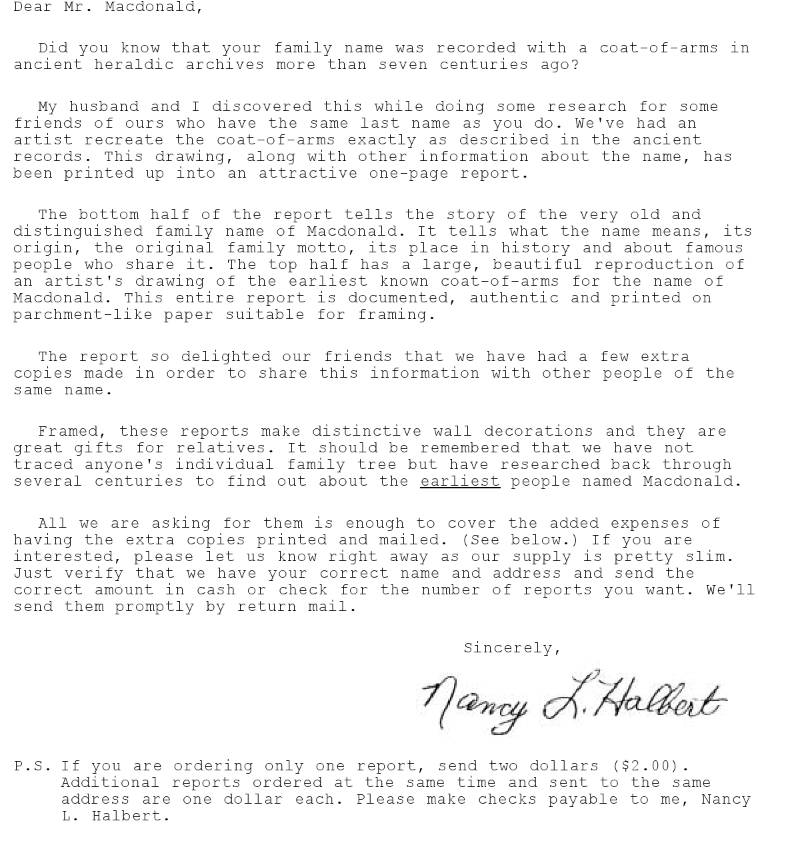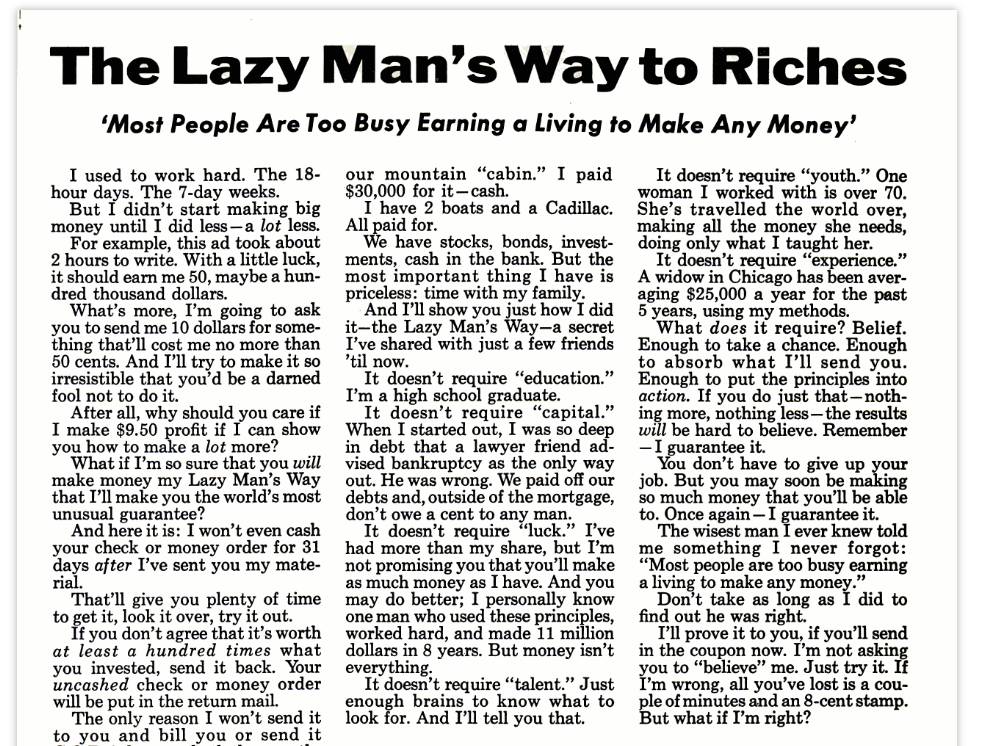Elevate your copywriting skills by learning from these classic copywriting examples.

Every industry has its legends. The people who disrupted the field, created notable work, and inspired their peers.
The copywriting legends that all beginner copywriters should know start with David Ogilvy, Gary Halbert, and Eugene Schwartz – but the list doesn’t end there. Reading copywriting examples from these leaders is essential when you’re starting out as a freelance copywriter.
You can study skills, techniques, and storytelling. But reading and hand-copying actual copywriting examples shows you how all these writing elements come to life.
But to learn the most, it’s important to choose effective and compelling copywriting examples. This article offers a list of classic samples to study, hand copy, and save for later.
Keep reading to learn:
I. Benefits of Studying Copywriting Examples
II. Copywriting Examples to Study and Hand Copy (And Why)
III. How to Build Your Own Copywriting Swipe File
The copywriting examples you’re about to read are considered some of the first groundbreaking works in advertising from the 1960s to the 1980s. Although copywriting has evolved since then, studying these foundational works is important.
The pieces use effective techniques like storytelling, emotion, and urgency. Understanding these techniques allows you to get bigger results with your copywriting.
These are some of the copywriting examples I studied and hand-copied when I first started out. And years later, my copy has helped generate over $27 million in sales for my clients.
So, when I began building my copywriting course, I knew I had to compose a list with these copywriting legends and more. These are some of the exact samples and strategies thousands of my copywriting students have studied. Many of these students have now produced thousands and even millions of dollars in sales with their copywriting.
Learn How to Build a Lucrative Freelance Copywriting Career
Get my free copywriting masterclass that walks you through exactly how I went from zero to consistent five-figure months with copywriting – with no experience and no portfolio.
Gain instant access – right to your inbox – when you sign up below. 👇
We will never spam you or share your email with anyone. In addition to the guide you’ll also receive semi-regular email updates with tips, tools, offers and exclusive resources. All emails include an unsubscribe link, you may opt-out at any time. Read our Privacy Policy to see how your data is handled.
Benefits of Studying Copywriting Examples
When you first start copywriting, it might surprise you to learn that copywriting is unlike any writing you’re used to. It even breaks some of the rules of academic writing and grammar you learned in school.
Effective copywriting is casual, conversational, and sounds like the way people talk. You’re probably not used to writing this way, so it may take some time to get used to.
Studying and hand-copying copywriting examples helps you absorb copywriting techniques and style. Actually, reading examples allows you to spot how copywriting techniques come to life in different ways and formats.
Classic copywriting examples provide a deeper understanding of the foundational copywriting skill. But it’s always helpful to keep adding samples to your copywriting swipe file, even as you continue to grow as a writer.
Here are a few benefits of studying copywriting examples:
- Solidify your skill set. The #1 advice seasoned copywriters give beginners is to hand copy effective copywriting examples. Writing things down activates your brain and stimulates your memory which engrains the skills in your mind.
Plus, hand copying takes more time than typing on a computer. This extra time allows your brain to process the words deeper and notice more elements. - Get writing inspiration. Your copywriting swipe file is your secret weapon as a copywriter. It’s much easier to write a copywriting piece when you have examples to look at instead of starting from scratch on a blank page.
Remember, it’s never acceptable to plagiarize someone else’s work. Plagiarism is unethical and harms SEO and your readers’ trust. A swipe file is purely for getting inspiration and formatting ideas. Make sure you’re creating new, original work!
- Keep your writing relevant. Just like other industries, copywriting evolves over time. Keeping up with marketing trends, language nuances, and the latest copywriting strategies is crucial.
Studying classic copywriting examples helps you solidify your skills. But it’s also helpful to save current examples to understand what performs well in modern times.
Want to become one of the top copywriters in your niche? Study the techniques and strategies that perform well, stand out, and grab the reader’s attention.
It sounds simple, but studying copywriting examples is one of the best ways to learn copywriting – and grow your skills to the next level. But it’s important to make sure you’re learning from proven, effective samples (like the ones below).
5 Copywriting Examples to Study and Hand Copy (And Why)
Like I said, hand copying is a proven way to learn and grow your copywriting skills. It helps your brain pick up on new things and reinforces your learning.
If you’re thinking, “that would take too long!” I get it.
With all our digital notes and documents, it’s probably been some time since you’ve written something by hand (I know it’s been a while for me).
But hand copying is absolutely worth your time. I’ve had tons of copywriting students feel resistant to this exercise. Those same students later said they were surprised and excited by how quickly they picked up on skills by hand copying.
And you don’t need to spend all day on this practice. Even just 30 minutes per day for 30 days goes a long way in helping you learn.
Set yourself up for success by considering what you’ll observe when you hand-copy the copywriting examples. Here are a few questions to think about:
- What kinds of words are they using and why?
- What is emphasized? Why do you think that is?
- How are they using grammar?
- Who do you think the audience is?
- Did it make you imagine anything?
- Is there a P.S.? What point does it serve?
- Highlight sentences that evoke emotion. Write down that emotion.
- Notice the cadence and flow.
It’s easy to accidentally go into autopilot mode while hand copying. But the value comes from really studying the word choice, flow, and storytelling aspects. If you start to feel your eyes glazing over while writing, just take a break and come back to it later.
5 Classic Ad Copywriting Examples
Let’s review the classic copywriting examples from the 1960s to 1980s and what they do well.
Copywriting has evolved in some ways since these were published. Yet they still include the foundational skills of effective copywriting. That’s why studying the works of legendary advertisers is still an essential piece of a new copywriter’s learning journey.
1. “Worst-Kept Secret” Rolls-Royce Ad by David Ogilvy

David Ogilvy was a legendary advertising executive widely regarded as one of the most influential figures in the advertising industry. In 1948 he founded Ogilvy & Mather, which became one of the world’s largest and most successful advertising agencies.
The “Worst-Kept Secret” Rolls-Royce ad by Ogilvy is a prime copywriting example of how to communicate the benefits of a product. The ad tells the reader exactly what the product is, the major benefits to consider – and reasons to buy one now.
Here are some learnings to consider about this ad:
- Speaks to their ideal audience. Captures the attention of their ideal client by using language that appeals to them. The phrases that communicate luxury and elegance appeal to a wealthy audience that would be the right fit for the car.
- Highlights the product’s unique value. Communicates the unique selling point of Rolls-Royce as a luxury car designed for those who demand the very best. The ad emphasizes the car’s attention to detail, comfort, and exclusivity.
- Uses compelling writing techniques. Uses several writing techniques like repetition, imagery, and emotion to connect with the reader. For example, the repetition of the phrase “the best car in the world” reinforces the product’s unique value.
- Hooks with a strong headline: “At 60 miles an hour, the loudest noise in this Rolls-Royce comes from the electric clock” is attention-grabbing and immediately draws the reader in. It also highlights the car’s attention to detail and level of luxury.
- Draws on credibility: Uses the Rolls-Royce brand’s reputation to add credibility to the message. The ad points out that the car is the preferred choice of royalty, celebrities, and other wealthy individuals, which reinforces its exclusivity and high status.
Overall, the “Worst-Kept Secret” Rolls-Royce ad is a compelling copywriting example of how to speak directly to your target audience. It also highlights the product’s unique selling points.
2. 55-Year-Old Golfer by John Carlton

John Carlton is a well-known copywriter and marketing consultant who has been active in the industry since the 1980s. He started in the advertising industry as a freelance writer and has worked with a wide range of clients—from small businesses to Fortune 500 companies.
The “55-Year-Old Golfer” by John Carlton is widely regarded as a top copywriting example for its use of storytelling, social proof, emotional connection, and more.
Here are some learnings to consider about this ad:
- Uses strong storytelling. Draws you in by starting with a story of a 55-year-old golfer who improves his game dramatically after using the advertised product. The story engages you and makes the product benefits more relatable.
- Appeals to emotion. Taps into the reader’s desire for better golf performance and the frustration of not being able to improve. He also creates a sense of urgency by emphasizing that the product is only available for a limited time.
- Uses social proof. Includes testimonials from satisfied customers, which adds to the credibility of the product and helps overcome any objections or skepticism that readers may have.
- Compelling writing techniques. Uses persuasive writing techniques throughout the letter, including curiosity hooks, benefits-focused headlines, and strong calls to action. He also uses “power words” and vivid imagery to create a strong emotional impact.
Never underestimate the power of storytelling in your writing. Communicating your point through a story is a very effective way to connect with the reader. The “55-Year-Old Golfer” is a prime example of how to do so.
3. Burn Disease Out of Your Body by Eugene Schwartz

Eugene Schwartz was an American advertising copywriter and author best known for his work in direct-response copywriting. He began his career in the mailroom at the advertising agency BBDO before working his way up to be a copywriter. Pretty cool, right?
Schwartz’s most famous book, “Breakthrough Advertising,” is considered a copywriting classic. And this ad, “Burn Disease Out of Your Body,” is a top example of direct-response copy.
Here are some learnings to consider about this ad:
- Uses a powerful headline. “Burn Disease Out of Your Body” is attention-grabbing and creates a strong emotional response. It suggests that the product can cure disease and improve health, which is impressive.
- Communicates the unique value. Says the product uses a special “formula” to boost the body’s natural defenses and heal itself. This sets it apart from other health products and makes it more appealing to readers.
- Appeals to emotion. Uses emotional appeals to create a sense of urgency and motivate readers to take action. He talks about the pain caused by illness and highlights the benefits of using the product to achieve better health and happiness.
- Provides detailed information. Highlights information about the product, including how it works, what it contains, and how it can benefit the reader. This helps build credibility and overcome any skepticism that readers may have.
“Burn Disease Out of Your Body” is well-written, informative, and emotionally compelling. This trifecta makes it a powerful example of effective copywriting.
4. Coat of Arms by Gary Halbert

Gary Halbert was an American copywriter and marketing expert widely regarded as one of the greatest copywriters of all time. He’s known for his innovative – and sometimes controversial – approach to copywriting.
The “Coat of Arms” letter is one of Halbert’s most well-known copywriting pieces. It’s a copywriting example of using storytelling, emotion, and a unique offer to sell a product.
Here are some learnings to consider about this ad:
- Tells a compelling story. The letter begins with a story of a wealthy family who discovers a “secret society” that has passed down a formula for wealth and success for centuries. This creates an intriguing mystery that draws the reader in and keeps them engaged throughout the letter.
- Appeals to emotion. Uses emotional appeals to tap into the reader’s desires and fears. He talks about the pain of financial struggle and the desire for success and financial security. He also creates a sense of urgency by emphasizing limited availability.
- Communicates a unique offer. Offers a detailed blueprint for success that promises to unlock the reader’s potential for wealth and prosperity. The offer is presented as exclusive and highly valuable, which adds to its appeal.
- Connects on a personal level. Uses a conversational tone and speaks directly to the reader, creating a connection and building trust. He also addresses common objections and concerns that readers may have, which helps overcome resistance to the offer.
Like the other samples, the “Coat of Arms” is a classic example of persuasive copywriting. It effectively uses benefits-focused copy, emotional appeals, social proof, and other persuasive writing techniques.
5. The Lazy Man’s Way To Riches by Joe Karbo

Joe Karbo was an American author and marketer best known for his book “The Lazy Man’s Way to Riches,” which became a bestseller in the 1970s. The book is a self-help guide to personal finance and success.
It’s notable for its unconventional approach to wealth-building. The book also emphasizes the importance of mindset, creativity, and unconventional thinking over hard work and sacrifice.
Here are some learnings to consider about this excerpt:
- Uses an attention-grabbing headline. “The Lazy Man’s Way to Riches” immediately grabs the reader’s attention and creates a sense of curiosity. It hints at a simple and easy solution to a common desire: becoming wealthy.
- Focuses on benefits. Highlights the specific benefits the reader will gain from the product, like financial independence and more free time. The product is a series of audio tapes that teach the reader how to become wealthy.
- Appeals to emotion. Uses emotional techniques to tap into the reader’s desires and frustrations. It emphasizes pain points and the desire for wealth. It also creates a sense of urgency by highlighting the limited availability of the product.
- Uses a personal story. Karbo tells the story of his own struggle with poverty and how he overcame it. This builds credibility and creates a sense of empathy with the reader by communicating that Karbo has been in their shoes.
You might be starting to notice the repeating themes in these copywriting examples. That’s because they all use specific foundational techniques of effective copywriting – like storytelling, emotional appeal, social proof, and urgency.
Once you uncover these techniques, you start seeing them everywhere! From the billboard ads you read on your way to work to the back cover of the book you’re reading.
Copywriting is everywhere. And now, you have a better idea of the copywriting examples and techniques to emulate in your writing.
How to Build Your Own Copywriting Swipe File
We went over classic copywriting examples from legendary marketers and advertisers. But you might have noticed that some of these are a little outdated. How do you make sure your copywriting stays up-to-date with the latest techniques and formats?
Adding modern copywriting examples to your copywriting swipe file is one of the smartest ways to save time and write effective copy.
But most copywriters’ swipe files will look different depending on your niche, offers, and areas of specialty. Here are a few tips for making your file unique and helpful to you:
- Study leaders in your niche. This article covered some of the legends of copywriting in general. But who are the modern-day experts in your copywriting niche? Study their work, offers, and writing formats.
- Organize your copywriting examples. Once you’ve collected samples in your niche, organize them in a way that makes sense to you. You can use folders, spreadsheets, or other tools to keep your examples organized and easy to find.
- Update your swipe file regularly. Keep your swipe file up to date by adding new examples as you come across them. Regularly reviewing your swipe file can help you stay updated on the latest trends and techniques in copywriting.
Having a swipe file with copywriting examples in your niche is so helpful when you’re starting a new project or feeling a bit of writer’s block. You can use your swipe file to get re-inspired or find a fresh perspective.
Draw from the examples in your swipe file for inspiration and guidance. But remember to adapt the ideas and techniques to fit your own unique writing style and client’s brand.
How to Study Effective Copywriting
Are you a beginner copywriter feeling a little overwhelmed with the learning process?
You’re constantly searching the web for resources, copywriting examples, marketing how-to’s, and more. You wish you could have all the information you need clearly laid out in one place.
Write Your Way to Freedom is exactly what you’re looking for. It’s the step-by-step roadmap to get from where you are now to being a high-earning freelance copywriter.
Write Your Way to Freedom teaches you foundational copywriting skills – like persuasive methods, emotional techniques, copywriting examples, and so much more.
But copywriting is only one piece of the puzzle. You also need to know how to pitch and land high-paying clients to be a successful freelancer copywriter.
That’s why you also get access to career-building strategies like how to build your portfolio, pitch clients, and level up as your business grows.
Are you ready to create the life you want with freelance copywriting? Apply for a strategy session to learn if Write Your Way to Freedom is right for you







